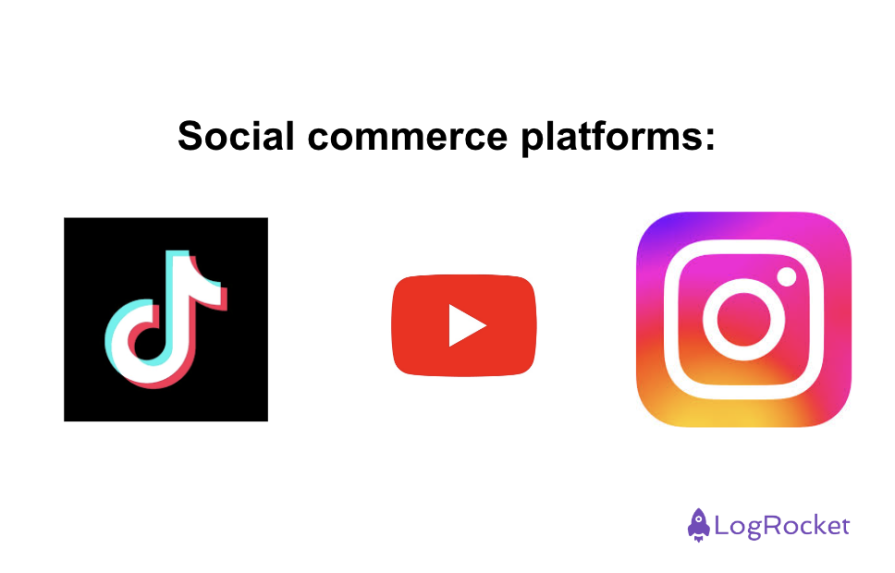If you’ve used TikTok, Instagram, or YouTube, there’s a good chance you’ve seen the fitness influencer Swolenormous. In his famous video series he yells in an angry tone for people to, “Go to the gym.”

Recently while browsing his videos on Instagram, I saw a shopping icon on all of his videos. Intrigued, I clicked on the video, only to realize that he has a shop where his audience can buy his merchandise. You click on “view shop” and it takes you to his storefront:

This mode of influencing relies on creating engaging content to build a network of potential customers. However, doing so requires an understanding of psychology, social human behavior, creativity, and business acumen. Collectively these factors determine social commerce.
The following article provides a guide to social commerce, including its benefits, examples of it in practice, and practical tips for streamlining its implementation.
Social commerce occurs when companies use social media platforms to sell products or services. It leverages the social media aspects of Facebook, Instagram, TikTok, Pinterest, LinkedIn, and other social media platforms to educate and entertain users and in the end sell them a product or service. This makes it more interactive, humane, and communal.
Social commerce differs from the traditional way of selling that Amazon and other online/offline retailers do. While these retailers sell directly to users, in social commerce, selling is less direct. A wall of content stands between the user and the business and this content helps the users to decide whether or not they should buy the product.
The following are some of the most common ways to integrate online shopping with social media applications.
When it comes to content-based product discovery, there tends to be two main approaches: organic content and sponsored ads. The first describes the situation most content creators find themselves in. Creators tend to lean towards either long-form content on platforms such as YouTube, or short-form with TikTok and Instagram to make videos and posts that a curated audience of followers interacts with.
On the other side of things, some brands produce sponsored ads where you would pay creators to produce content on behalf of the brand. While this can be effective, you should always weigh the cost of sponsorship against the relative low investment of organic content.
This kind of integration goes back to the example of Swolenormous that I shared at the start of the document. He creates content linked to a specific product. Users then watch this content and can click to go to the advertised product.
Another popular way to drive sales through social media involves a network of creators who review and recommend products. Here you leverage the trust customers have in a particular creator to build credibility and expand brand awareness.
Social commerce tends to perform much better than traditional commerce. The following benefits highlight its value.
Since a lot of content about the product comes from creators, it helps to increase the trust within the brand. This can help to convert customers via impulsive buying and in turn, produce more sales.
With increased trust comes increased sales and conversions. Also, with less friction in the buying decision, it can increase the likelihood of returning customers.
This form of marketing method is less expensive than traditional marketing methods. Since the content is generated by creators, you only need to pay them a set fee at the end. This leads to fairly lower costs.
Sure, it depends on how much the creators would charge, but smaller creators with a specific following similar to the target audience of the company will still be cheaper than traditional marketing.
Since most of the big platforms have personalization algorithms already in place, content goes in front of an audience already more likely to buy. This helps with the conversion and sales without explicitly investing in personalization.
Since all of the social media platforms have comments, likes, messages, live streams, etc. as channels to communicate with the users, it helps you understand what customers are looking for and thereby build products/services accordingly. This reduces the time and cost to build something that potentially the users might not like.
The market is filled with big names such as Instagram, Facebook, YouTube, TikTok, Pinterest, Snapchat, and others when it comes to social media platforms. These three platforms though offer the most potential for social commerce:

With social commerce platforms in mind, the following strategies help you better connect with your users and sell more of your product.
Even though YouTube, TikTok, Instagram, Snapchat, and others have a lot of social commerce features, at the core, all these social media platforms are different from each other. Hence it’s important to understand who your users are and which platforms these users prefer.
If your target audience is under 20, there’s a high chance these users are on TikTok and Snapchat, while if your audience is more than 30 years of age, there is a high chance these users are on Instagram and YouTube. So knowing your audience will help you to prioritize the platform.
Small creators narrow their target audience compared to bigger creators. Because of this, it can be more effective to collaborate with smaller creators. These creators also tend to have a more engaged audience that gives you feedback to make your product better.
When you advertise on social media platforms or collaborate with creators to help spread the word, create exclusive deals and discounts that the users can’t find anywhere else. This motivates users to come back to the platform for newer deals and discounts.
While social commerce offers a lot of benefits, you should keep an eye on future trends within the industry as they can quickly disrupt your strategy. You always want to stay up-to-date on the latest changes. Some of these include.
Influencers will play a big role in social commerce in the coming times. The more trust a user has in the brand, the higher the chance of them to come back to the brand. Brands will also leverage micro/small influencers for growth because of their well-targeted audiences.
I run a series called “101 Things To Do In Berlin” and have 2.5K followers. Since my content focuses on Berlin specifically, smaller pop-up stores reach out to me for collaborations.
AI content will continue to play a bigger and bigger role within social commerce. This will also force the big social media platforms to develop an AI strategy to prevent AI-generated content from taking over feeds.
Niche and smaller communities will grow alongside small/micro-influencer and provide a specific target audience. This enables you to know where to prioritize spending.
Voice commerce has a lot of potential going forward with the rise of Alexa and Google Home. It removes friction and makes the social commerce experience much smoother, in turn leading to increased sales and conversion.
Whether you like it or not, social media is here to stay and will only continue to play a larger role in getting your product in front of your target audience. Social commerce leverages trust to supercharge ROI and personalize the shopping experience. Alongside this, social commerce requires considerably less budget than traditional forms of marketing and advertising, enabling smaller brands to grow and reach a wider audience.
Regardless of your exposure to social, keep this article in mind when crafting your product strategy. As always, feel free to comment any questions you may have. Good luck!
gd2md-html: xyzzy Mon Jul 22 2024
Featured image source: IconScout

LogRocket identifies friction points in the user experience so you can make informed decisions about product and design changes that must happen to hit your goals.
With LogRocket, you can understand the scope of the issues affecting your product and prioritize the changes that need to be made. LogRocket simplifies workflows by allowing Engineering, Product, UX, and Design teams to work from the same data as you, eliminating any confusion about what needs to be done.
Get your teams on the same page — try LogRocket today.

A practical guide for PMs who want to stop being bottlenecks, delegate smarter, and lead teams effectively with a clear ownership framework.

Stop letting unreliable data block features. Treat data as inventory to track quality, ownership, and ship with confidence.

Learn why slide decks slow teams down and explore better tools like whiteboards, PRDs, and prototypes to improve collaboration and alignment.

AI PM roles are evolving fast. Learn the five types of AI PMs, the skills they need, and how they shape AI products across industries.